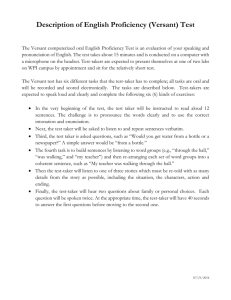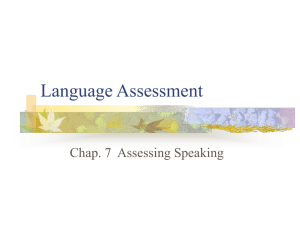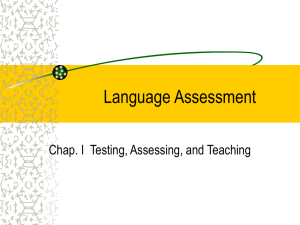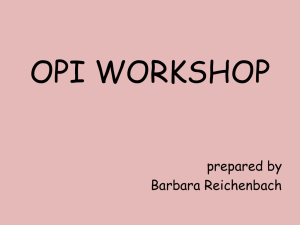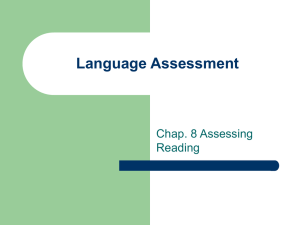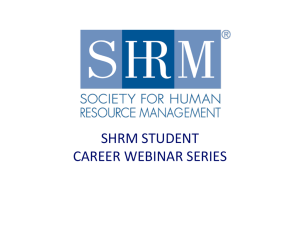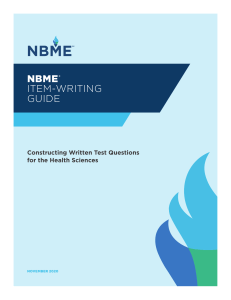designing assessment tasks : interactive speaking
advertisement
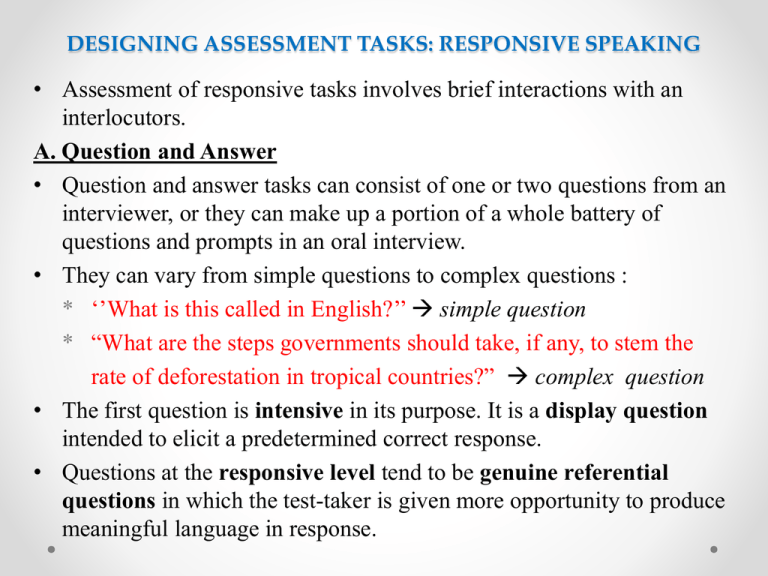
DESIGNING ASSESSMENT TASKS: RESPONSIVE SPEAKING • Assessment of responsive tasks involves brief interactions with an interlocutors. A. Question and Answer • Question and answer tasks can consist of one or two questions from an interviewer, or they can make up a portion of a whole battery of questions and prompts in an oral interview. • They can vary from simple questions to complex questions : * ‘’What is this called in English?’’ simple question * “What are the steps governments should take, if any, to stem the rate of deforestation in tropical countries?” complex question • The first question is intensive in its purpose. It is a display question intended to elicit a predetermined correct response. • Questions at the responsive level tend to be genuine referential questions in which the test-taker is given more opportunity to produce meaningful language in response. • Responsive questions may take the following forms: Questions eliciting open-ended responses Test-takers hear : 1. What do you think about the weather today? 2. What do you like about the English language? 3. Why did you choose your academic major? 4. What kind of strategies have you used to help you learn English? 5. a. Have you ever been to the United States before? b. What other countries have you visited? c. Why did you go there? What did you like best about it? d. If you could go back, what would you like to do or see? e. What country would you like to visit next, and why? Test-takers respond with a few sentences at most. Notice that question #5 has five situationally linked questions that may vary slightly depending on the test-taker’s response to a previous question. Elicitation of questions from the test-taker Test-takers hear: * Do you have any questions for me? * Ask me about my family or job or interests. * If you could interview the president or prime minister of your country, what would you ask that person? Test-takers respond with questions. A potentially tricky form of oral production assessment involves more than one test-taker with an interviewer. B. Giving Instructions and Directions The technique is simple: the administrator poses the problem, and the test-taker responds. Scoring is based primarily on comprehensibility and secondarily on other specified grammatical or discourse categories. Test-takers hear: * * * * * * Describe how to make a typical dish from your country. What’s a good recipe for making ______ ? How do you access email on a PC computer? How would I make a typical costume for a ____ celebration in your country? How do you program telephone numbers into a cell (mobile) phone? How do I get from ______ to ______ in your city? Test-takers respond with appropriate instructions/directions. C. Paraphrasing The test-takers read or hear a limited number of sentences (perhaps two or five) and produce a paraphrase of the sentence. Paraphrasing a story Test-takers hear: Paraphrase the following little story in your own words. My weekend in the mountains was fabulous. The first day we backpacked into the mountains and climbed about 2.000 feet. The hike was strenuous but exhilarating. By sunset we found these beautiful alpine lakes and made camp there. The sunset was amazingly beautiful. The next two days we just kicked back and did little day hikes, some rock climbing, bird watching, swimming, and fishing. The hike out on the next day was really easy – all downhill – and the scenery was incredible. Test-takers respond with two or three sentences. A more authentic context for paraphrase is aurally receiving and orally relaying a message. Paraphrasing a phone message Test-taker hear: please tell Jeff that I’m tied up in traffic so I’m going to be about a half late for the nine o’clock meeting. And ask him to bring up our question about the employee benefits plan. If he wants to check in with me on my cell phone, have him call 415-338-3095. Thanks. Test-takers respond with two or three sentences. If you use short paraphrasing tasks as an assessment procedure, it’s important to pinpoint the objective of the task clearly. TEST OF SPOKEN ENGLISH (TSE) • The TSE is a 20 minute audio-taped test of oral language ability within an academic or professional environment. • Lazaraton and Wagner (1996) examined 15 different specific tasks in collecting background data from native and non-native speakers of English. 1. giving a personal description 2. describing a daily routine 3. suggesting a gift and supporting one’s choice 4. recommending a place to visit and supporting one’s choice 5. giving directions 6. describing a favorite movie and supporting one’s choice 7. telling a story from pictures 8. hypothesizing about future action 9. hypothesizing about a preventive action 10. making a telephone call to the dry cleaner 11. describing an important news event 12. giving an opinion about animals in the zoo 13. defining a technical term 14. describing information in a graph and speculating about its implications 15. giving details about a trip schedule From their findings, the researchers were able to report on the validity of the tasks, especially the match between the intended task functions and the actual output of both native and non-native speakers. Test of Spoken English scoring guide (1995) TSE Rating Scale 60 Communication almost always effective: task performed very competently; speech almost never marked by non-native characteristics 50 Communication generally effective: task performed competently, successful use of compensatory strategies; speech sometimes marked by on-native characteristics 40 Communication somewhat effective: task performed somewhat competently, some successful use of compensatory strategies; speech regularly marked by non-native characteristics 30 Communication generally not effective: task generally performed poorly, ineffective use of compensatory strategies; speech very frequently marked by non-native characteristics 20 No effective communication: no evidence of ability to perform task, no effective use of compensatory strategies; speech almost always marked by non-native characteristics • The original version of the TSE (1987) specified three contributing factors to a final score on “overall comprehensibility”: pronunciation, grammar, and fluency. • The current scoring scale of 20 to 60 listed above incorporates task performance, function, appropriateness, and coherence as well as the formfocused factors. • Classroom teachers who propose to model oral production assessments after the tasks on the TSE must, in order to provide some wash-back effect, be more explicit in analyzing the various components of test-takers’ output. Such scoring rubrics are presented in the next section. Test of Spoken English (TSE) • Producer • Objective • Primary market • Type • • • • Response modes Specifications Time allocation Internet access : Educational Testing Service, Princeton, NJ : To test oral production skills of non-native English speakers : Primarily used for screening international teaching assistants in universities in the United States; a growing secondary market is certifying health professionals in the United States : Audio-taped with written, graphic, and spoken stimuli : Oral tasks; connected discourse : (see sample items above) : 20 minutes : http://www.toef.org/tse/tseindx.html DESIGNING ASSESSMENT TASKS : INTERACTIVE SPEAKING A. INTERVIEW “Oral production assessment” oral interview tape recorded interview • TWO KINDS OF INTERVIEW a. Placement Interview Designed to get a quick spoken sample from a student in order to verify placement into course b. Comprehensive Interview (OPI) Designed to cover predetermined oral production contexts and may require the better part of an hour. MICHAEL CANALE (1984) 1. FOUR MANDATORY STAGES WARM – UP The interviewer direct mutual introductions, helps the test-taker become comfortable with the situation, appraises the test – taker of the format and allays anxieties. No scoring takes place. 2. LEVEL CHECK The interviewer stimulates the test taker to respond using expected or predicted forms and functions. Question are design to elicit grammatical categories, discourse structure, vocabulary usage and/or sociolinguistic factors. This stage give the interviewer a picture of the test-taker’s extroversion, readiness to speak and confidence. Linguistic target criteria are scored in this phase. 3. PROBE Challenge test-takers to go to the heights of their ability, to extend beyond the limits of the interviewer’s expectation through increasingly difficult questions. Through probe items, the interviewer discovers the ceiling or limitation of the test-taker proficiency. At the lower level of proficiency It may simply demand higher range of vocabulary and grammar. At the higher level of proficiency It will typically ask the test taker to give an opinion or a value judgment, to discuss his/her field of specialization, to recount a narrative, or to respond to questions that are wondered in complex form. 4. WIND-DOWN The interviewer encourages the test-taker to relax with some easy questions This part is not scored. The success of an oral interview will depend on : 1. Clearly specifying administrative procedures of the assessment (practicality) 2. Focusing the questions and probes on the purpose of the assessment (validity). 3. Appropriately eliciting an optimal amount and quality of oral production from the test-taker (biased for best performance). 4. Creating a consistent, workable scoring system (reliability). A VARIATION ON THE USUAL ONE-ON-ONE FORMAT IS TO PLACE TWO-ON-ONE FORMAT ADVANTAGE • Practically can examine many candidates in the same time. • There is an opportunity for student-student interaction DISADVANTAGE • Equalizing the output between the two test taker • Discerning the interaction effect of unequal comprehension and production ability • Scoring two people simultaneously B. Role Play 1. It frees students to be more creative in their linguistic output. 2. It Allows some rehearsal time so that students can map out what they are going to say. 3. It has the effect of lowering anxieties as students can. 4. As an assessment device, role play opens some windows of opportunity for test taker to use discourse that might otherwise be difficult to elicit. 5. Certain personal, strategic, and linguistic factors come into the foreground of the test-taker’s oral abilities. 6. Role play takes test-takers beyond simple intensive and responsive levels to a level of creativity and complexity that approaches real-world pragmatics. C. Discussions and Conversations Discussion may be especially appropriate tasks through which to elicit and observe such abilities as: 1. Topic nomination, maintenance and termination 2. Attention getting, interrupting, floor holding, control; 3. Clarifying, questioning paraphrasing 4. Comprehension signals (nodding, “uh-uhh”, “hmm”, etc) 5. Negotiating meaning 6. Intonation patterns for pragmatic effect 7. Kinesics, eye contact, proxemics, body language 8. Politeness, formality and other sociolinguistic factors. D. Games Such tasks have wandered away from the traditional notion of an oral production test and may even be well beyond assessment. As assessment, the key is to specify a set of criteria and a reasonably practical and reliable scoring method. E. Oral Proficiency Interview (OPI) • Originally known as the Foreign Service Institute (FSI) test. • OPI is designed to elicit pronunciation, fluency and integrative ability, sociolinguistic and cultural knowledge, grammar, and vocabulary. • Performance is judged by the examiner to be at one of ten possible levels on the ACTFL- designed proficiency guidelines for speaking : superior – advanced – intermediate - Novice • The ACTFL (American Council on Teaching Foreign Language) proficiency guidelines may appear to be just another form of the “FSI Level” described earlier. Holistic evaluation is still implied, and in this case four levels are described. On closer scrutiny, however, they offer a markedly different set of descriptors. 1. They are more reflective of a unitary definition of ability 2. For classroom assessment purposes, the six FSI categories more appropriately describe the components of oral ability than do the ACTFL holistic score and therefore offer better washback potential. 3. The ACTFL requirement for specialized training renders the OPI less useful for classroom adaptation. CRITICISM ON OPI • Valdman (1988,p.125) From a Vygotskyan perspective, the OPI forces test-takers into a closed system where, because the interviewer is endowed with full social control, they are unable to negotiate a social world. For example, the cannot nominate topics for discussion, they cannot switch formality levels, they cannot display a full range of stylistic maneuver. The total control the OPI interviewers possess is reflected by the parlance of the test methodology… In short, the OPI can only inform us of how learners can deal with an artificial social imposition rather than enabling us to predict how they would be likely to manage authentic linguistic interactions with targetlanguage native speaker. • Bachman (1988,p.149) pointed out that the validity of the OPI simply cannot be demonstrated “because it confounds abilities with elicitation procedures in its design, and it provides only a single rating, which has no basis in either theory or research.” DESIGNING ASSESSMENTS : EXTENSIVE SPEAKING • Extensive speaking tasks involve complex, relatively lengthy stretches of discourse. They are frequently variations on monologues, usually with minimal verbal interaction. A. ORAL PRESENTATION The rules for effective assessment must be invoked : a. Specify the criterion b. Set appropriate tasks c. Elicit optimal output d. Establish practical, reliable scoring procedures • Oral Presentation a checklist or grid is a common means of scoring or evaluation. • Holistic scores are tempting to use for their apparent practicality, but they may obscure the variability of performance across several subcategories, especially they two major components of content and delivery. • Its authenticity can be supported in that all of the items on the list contribute to an effective presentation. • The washback effect of such a checklist will be enhanced by written comments from the teacher, a conference with the teacher, peer evaluations using the same form, and selfassessment. B. PICTURED–CUED STORY -TELLING • One of the most common techniques for eliciting oral production is through visual pictures, photographs, diagrams, and charts. • As the example, look at picture page 181 C. Retelling a Story, News Event • Test-takers hear or read a story or news event that they are asked to retell. • It is a longer stretch of discourse and a different genre. • The objectives is to produce a number of oral discourse features (communicating sequences and relationships of events, stress and emphasis patterns, ‘’expression’’ in the case of a dramatic story), fluency, and interaction with the hearer. D. Translation (of Extended Prose) • Translation of words, phrases, or short sentences was mentioned under the category of intensive speaking. Here , longer texts are presented for the test-taker to read in the native language and then translate into English. • Those texts could come in many forms : dialogue, directions for assembly of a product, a synopsis of a story or play or movie, directions on how to find something on a map, and other genres. • The advantage of translation is in the control of the content, vocabulary, and to some extent, the grammatical and discourse feature. • The disadvantage is that translation of longer texts is a highly specialized skill
